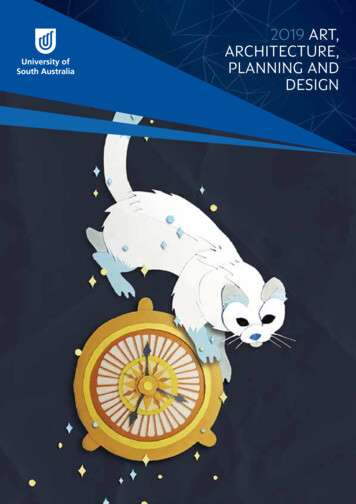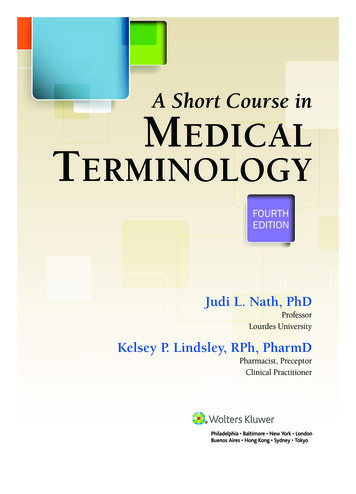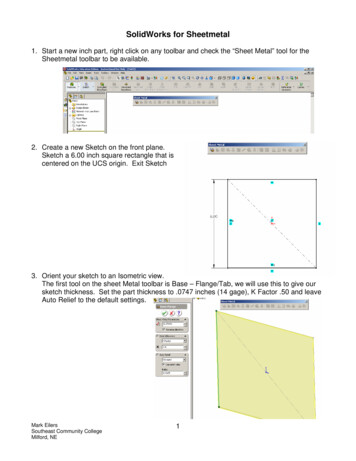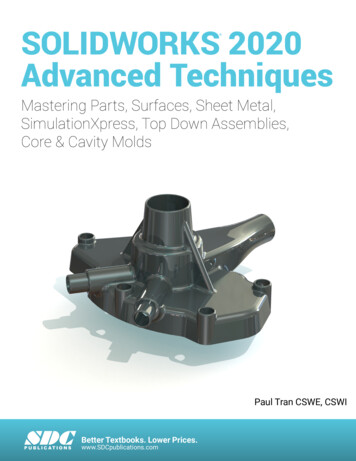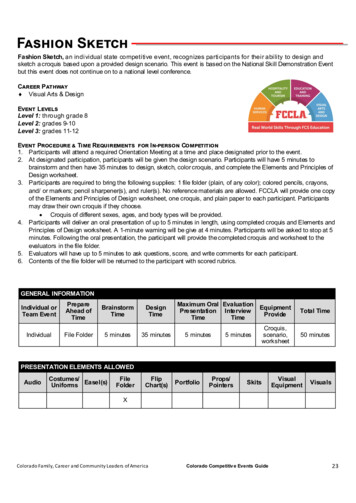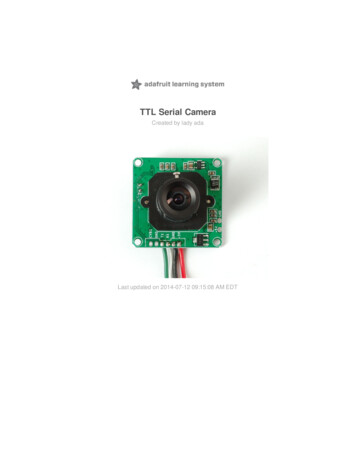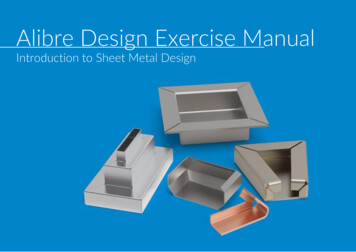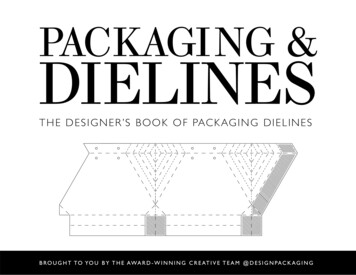
Transcription
C O N T E N T SUNIT IMaternal and Child HealthNursing Practice 1SEXUAL HARASSMENT 98DISORDERS OF SEXUAL FUNCTIONING 98CHAPTER 1Nursing Process Overview forReproductive Health 104A Framework for Maternaland Child Health Nursing 3GOALS AND PHILOSOPHIES OF MATERNALAND CHILD HEALTH NURSING 4STANDARDS OF MATERNAL AND CHILD HEALTHNURSING PRACTICE 5A FRAMEWORK FOR MATERNAL AND CHILDHEALTH NURSING CARE 5MATERNAL AND CHILD HEALTH NURSINGTODAY 8ADVANCED-PRACTICE ROLES FOR NURSES INMATERNAL AND CHILD HEALTH 22LEGAL CONSIDERATIONS OF MATERNAL-CHILDPRACTICE 23ETHICAL CONSIDERATIONS OF PRACTICE 24CHAPTER 2The Childbearing and Childrearing Familyand Community 26Nursing Process Overview forPromotion of Family Health 27THE FAMILY 28FAMILY FUNCTIONS AND ROLES 32ASSESSMENT OF FAMILY STRUCTUREAND FUNCTION 39THE FAMILY AS PART OF A COMMUNITY 41CHAPTER 3Sociocultural Aspects of Maternaland Child Health Nursing 49Nursing Process Overview That RespectsSociocultural Aspects of Care 50SOCIOCULTURAL DIFFERENCES AND THEIRIMPLICATIONS FOR MATERNAL ANDCHILD HEALTH NURSING 52UNIT IIThe Nursing Role in Preparing Familiesfor Childbearing and Childrearing 63CHAPTER 5Reproductive Life Planning 102CONTRACEPTIVES 105THE COUPLE WITH A PHYSICAL ORCOGNITIVE CHALLENGE 124FUTURE TRENDS IN CONTRACEPTION 125ELECTIVE TERMINATION OF PREGNANCY(INDUCED ABORTION) 125CHAPTER 6The Infertile Couple 133Nursing Process Overview forthe Couple With Infertility 134INFERTILITY 136FERTILITY ASSESSMENT 139INFERTILITY MANAGEMENT 146ALTERNATIVES TO CHILDBIRTH 151UNIT IIIThe Nursing Role in Caringfor the Pregnant Family 155CHAPTER 7Genetic Assessment and Counseling 157Nursing Process Overview for GeneticAssessment and Counseling 158GENETIC DISORDERS 159GENETIC COUNSELING 167COMMON CHROMOSOMAL DISORDERSRESULTING IN PHYSICAL OR COGNITIVEDEVELOPMENTAL DISORDERS 176CHAPTER 8The Growing Fetus 181Nursing Process Overview toHelp Ensure Fetal Health 182STAGES OF FETAL DEVELOPMENT 182EMBRYONIC AND FETAL STRUCTURES 184ORIGIN AND DEVELOPMENTOF ORGAN SYSTEMS 189ASSESSMENT OF FETAL GROWTHAND DEVELOPMENT 197CHAPTER 4Reproductive and Sexual Health 65CHAPTER 9Nursing Process Overview for Promotionof Reproductive and Sexual Health 66Psychological and PhysiologicChanges of Pregnancy 212REPRODUCTIVE DEVELOPMENT 68ANATOMY AND PHYSIOLOGY OF THEREPRODUCTIVE SYSTEM 69MENSTRUATION 83SEXUALITY AND SEXUAL IDENTITY 87HUMAN SEXUAL RESPONSE 93Nursing Process Overview for HealthyAdaptation to Pregnancy 213PSYCHOLOGICAL CHANGES OF PREGNANCY 214THE PSYCHOLOGICAL TASKSOF PREGNANCY 215xvii
xviiiContentsTHE DIAGNOSIS OF PREGNANCY 222PHYSIOLOGIC CHANGES OF PREGNANCY 225CHAPTER 10Assessing Fetal and Maternal Health:Prenatal Care 240Nursing Process Overviewfor Prenatal Care 241HEALTH PROMOTION DURING PREGNANCY 242HEALTH ASSESSMENT DURING THEFIRST PRENATAL VISIT 242CHAPTER 11Promoting Fetal and Maternal Health 271Nursing Process Overview for HealthPromotion of a Fetus and Mother 272HEALTH PROMOTION DURING PREGNANCY 274DANGER SIGNS OF PREGNANCY 286PREVENTING FETAL EXPOSURETO TERATOGENS 287PREPARING FOR LABOR 295CHAPTER 12Promoting Nutritional HealthDuring Pregnancy 299Nursing Process Overview forPromoting Nutritional Healthin the Pregnant Woman 300RELATIONSHIP OF MATERNAL NUTRITION TOINFANT HEALTH 302ASSESSMENT OF NUTRITIONAL HEALTH 307PROMOTING NUTRITIONAL HEALTHDURING PREGNANCY 308CHAPTER 13Preparation for Childbirth and Parenting 323Nursing Process Overview for Childbirthand Parenting Education 324CHILDBIRTH EDUCATION 326PRECONCEPTION CLASSES 327EXPECTANT PARENTING CLASSES 327THE CHILDBIRTH PLAN 328PREPARATION FOR CHILDBIRTH CLASSES 329THE BIRTH SETTING 336ALTERNATIVE METHODS OF BIRTH 341CHAPTER 14High-Risk Pregnancy: A Woman With aPreexisting or Newly Acquired Illness 344Nursing Process Overview for Care of aWoman With a Preexisting or NewlyAcquired Illness 345IDENTIFYING THE HIGH-RISK PREGNANCY 347SEXUALLY TRANSMITTED INFECTIONSAND PREGNANCY 347CARDIOVASCULAR DISORDERSAND PREGNANCY 353HEMATOLOGIC DISORDERSAND PREGNANCY 361RENAL AND URINARY DISORDERSAND PREGNANCY 364RESPIRATORY DISORDERS AND PREGNANCY 366RHEUMATIC DISORDERS AND PREGNANCY 370GASTROINTESTINAL DISORDERSAND PREGNANCY 371NEUROLOGIC DISORDERS AND PREGNANCY 373MUSCULOSKELETAL DISORDERSAND PREGNANCY 375ENDOCRINE DISORDERS AND PREGNANCY 376CANCER AND PREGNANCY 383MENTAL ILLNESS AND PREGNANCY 384TRAUMA AND PREGNANCY 384CHAPTER 15High-Risk Pregnancy: A Woman Who Developsa Complication of Pregnancy 398Nursing Process Overview for Caring fora Woman Who Develops a Complicationof Pregnancy 399BLEEDING DURING PREGNANCY 400CONDITIONS ASSOCIATED WITHFIRST-TRIMESTER BLEEDING 402CONDITIONS ASSOCIATED WITHSECOND-TRIMESTER BLEEDING 410CONDITIONS ASSOCIATED WITHTHIRD-TRIMESTER BLEEDING 413PRETERM LABOR 417PRETERM RUPTURE OF MEMBRANES 425PREGNANCY-INDUCED HYPERTENSION (PIH) 426HELLP SYNDROME 433MULTIPLE PREGNANCY 433HYDRAMNIOS 435POST-TERM PREGNANCY 436PSEUDOCYESIS 436ISOIMMUNIZATION (RH INCOMPATIBILITY) 436FETAL DEATH 438CHAPTER 16Home Care of the Pregnant Client 443Nursing Process Overview for the PregnantWoman on Home Care 444HOME CARE 449NURSING RESPONSIBILITIES FOR HOME CARE 453CHAPTER 17High-Risk Pregnancy: A Woman WithSpecial Needs 461Nursing Process Overview for Care of aPregnant Woman With Special Needs 462THE PREGNANT ADOLESCENT 463THE PREGNANT WOMAN OVER AGE 40 472THE PREGNANT WOMAN WHO IS PHYSICALLYOR COGNITIVELY CHALLENGED 476A WOMAN WHO IS SUBSTANCE DEPENDENT 480UNIT IVThe Nursing Role in Caring for theFamily During Labor and Birth 485CHAPTER 18Caring for a Woman During Vaginal Birth 487Nursing Process Overview for a Womanin Labor 488THEORIES OF LABOR ONSET 489SIGNS OF LABOR 489COMPONENTS OF LABOR 490STAGES OF LABOR 503MATERNAL AND FETAL RESPONSES TO LABOR 508MATERNAL AND FETAL ASSESSMENTDURING LABOR 512
ContentsCARE OF A WOMAN DURING THE FIRST STAGEOF LABOR 528CARE OF A WOMAN DURING THE SECOND STAGEOF LABOR 534CARE OF A WOMAN DURING THE THIRD ANDFOURTH STAGES OF LABOR 538UNIQUE CONCERNS OF A WOMAN IN LABOR 539CHAPTER 19Providing Comfort During Labor and Birth 542Nursing Process Overview for Pain ReliefDuring Childbirth 543EXPERIENCE OF PAIN DURING CHILDBIRTH 544COMFORT AND PAIN RELIEF MEASURES 546NURSING CARE TO PROMOTE THE COMFORTOF A WOMAN DURING LABOR 556CHAPTER 23Nursing Care of a Woman and FamilyExperiencing a Postpartal Complication 654Nursing Process Overview for a WomanExperiencing a Postpartal Complication 655POSTPARTAL HEMORRHAGE 656PUERPERAL INFECTION 663THROMBOPHLEBITIS 667MASTITIS 670URINARY SYSTEM DISORDERS 670CARDIOVASCULAR SYSTEM DISORDERS 674REPRODUCTIVE SYSTEM DISORDERS 674EMOTIONAL AND PSYCHOLOGICALCOMPLICATIONS OF THE PUERPERIUM 674CHAPTER 24CHAPTER 20Nursing Care of a Newborn and Family 679Cesarean Birth 564Nursing Process Overview for HealthPromotion of the Term Newborn 680Nursing Process Overview for a WomanHaving a Cesarean Birth 565CESAREAN BIRTH 566NURSING CARE OF A WOMAN ANTICIPATING ACESAREAN BIRTH 568NURSING CARE OF A WOMAN HAVING ANEMERGENCY CESAREAN BIRTH 572INTRAOPERATIVE CARE MEASURES 573POSTPARTAL CARE MEASURES 577CHAPTER 21The Woman Who Develops a ComplicationDuring Labor and Birth 588Nursing Process Overview for a WomanWith a Labor or Birth Complication 589COMPLICATIONS WITH THE POWER (THE FORCEOF LABOR) 590PROBLEMS WITH THE PASSENGER 598PROBLEMS WITH THE PASSAGE 606THERAPEUTIC MANAGEMENT OF PROBLEMSOR POTENTIAL PROBLEMS IN LABORAND BIRTH 607ANOMALIES OF THE PLACENTA AND CORD 615UNIT VThe Nursing Role in Caring for theFamily During the Postpartal Period 619CHAPTER 22Nursing Care of a Postpartal Womanand Family 621Nursing Process Overview for a PostpartalWoman and Family 622PSYCHOLOGICAL CHANGES OF THE POSTPARTALPERIOD 623PHYSIOLOGIC CHANGES OF THE POSTPARTALPERIOD 627NURSING CARE OF A WOMAN AND FAMILY DURINGTHE FIRST 24 HOURS AFTER BIRTH 633NURSING CARE OF A WOMAN AND FAMILY INPREPARATION FOR DISCHARGE 647NURSING CARE OF A WOMAN ANDFAMILY AFTER DISCHARGE 648NURSING CARE OF A POSTPARTAL WOMANAND FAMILY WITH UNIQUE NEEDS 650PROFILE OF A NEWBORN 681APPEARANCE OF A NEWBORN 689ASSESSMENT FOR WELL-BEING 700CARE OF A NEWBORN AT BIRTH 707NURSING CARE OF A NEWBORN AND FAMILY INTHE POSTPARTAL PERIOD 713ASSESSMENT OF FAMILY’S READINESS TOCARE FOR A NEWBORN AT HOME 715CHAPTER 25Nutritional Needs of a Newborn 722Nursing Process Overview for PromotingNutritional Health in a Newborn 723NUTRITIONAL ALLOWANCES FORA NEWBORN 724BREAST-FEEDING 726FORMULA-FEEDING 741DISCHARGE PLANNING 744CHAPTER 26Nursing Care of the High-Risk Newbornand Family 747Nursing Process Overview for theFamily of a High-Risk Newborn 748NEWBORN PRIORITIES IN FIRST DAYS OF LIFE 749THE NEWBORN AT RISK BECAUSE OF ALTEREDGESTATIONAL AGE OR BIRTHWEIGHT 757ILLNESS IN THE NEWBORN 777THE NEWBORN AT RISK BECAUSE OF MATERNALINFECTION OR ILLNESS 789UNIT VIThe Nursing Role in Health Promotionfor a Childrearing Family 797CHAPTER 27Principles of Growth and Development 799Nursing Process Overview for Promotion ofNormal Growth and Development 800IMPORTANCE OF KNOWLEDGE ABOUT GROWTHAND DEVELOPMENT TO THE ROLEOF THE NURSE 801PRINCIPLES OF GROWTH AND DEVELOPMENT 802xix
xxContentsFACTORS INFLUENCING GROWTHAND DEVELOPMENT 802THEORIES OF DEVELOPMENT 813CHAPTER 28The Family With an Infant 824Nursing Process Overview for HealthyDevelopment of an Infant 825GROWTH AND DEVELOPMENTOF AN INFANT 827THE NURSING ROLE IN HEALTH PROMOTIONOF AN INFANT AND FAMILY 838CHAPTER 29The Family With a Toddler 860Nursing Process Overview for HealthyDevelopment of a Toddler 861NURSING ASSESSMENT OF GROWTH ANDDEVELOPMENT OF A TODDLER 862PLANNING AND IMPLEMENTATION FOR HEALTHPROMOTION OF A TODDLER AND FAMILY 868CHAPTER 30The Family With a Preschooler 884Nursing Process Overview for HealthyDevelopment of the Preschooler 885INTELLIGENCE 1022TEMPERAMENT 1023IMMUNIZATIONS 1023CONCLUDING A HEALTH ASSESSMENT 1032CHAPTER 34Communication and Teaching With Childrenand Families 1036Nursing Process Overview for HealthTeaching With Children 1037COMMUNICATION 1038HEALTH TEACHING IN A CHANGING HEALTHCARE ENVIRONMENT 1046THE ART OF TEACHING 1046THE ART OF LEARNING 1048DEVELOPING AND IMPLEMENTING ATEACHING PLAN 1052HEALTH TEACHING FOR A SURGICALEXPERIENCE 1059UNIT VIIThe Nursing Role in Supportingthe Health of Ill Children andTheir Families 1065NURSING ASSESSMENT OF GROWTH ANDDEVELOPMENT OF THE PRESCHOOLER 886PLANNING AND IMPLEMENTATION FOR HEALTHPROMOTION OF THE PRESCHOOLERAND FAMILY 890CHAPTER 35CHAPTER 31THE MEANING OF ILLNESS TO CHILDREN 1069CARE OF THE ILL CHILD AND FAMILYIN THE HOSPITAL 1071CARE OF THE ILL CHILD AND FAMILYIN THE HOME 1081NURSING RESPONSIBILITIES FOR CAREOF AN ILL CHILD AND FAMILY 1085PROMOTING NUTRITIONAL HEALTHOF AN ILL CHILD 1089PROMOTING SAFETY FOR AN ILL CHILD 1091PROMOTING ADEQUATE SLEEPFOR AN ILL CHILD 1092PROMOTING ADEQUATE STIMULATIONFOR AN ILL CHILD 1094PROMOTING PLAY FOR AN ILL CHILD 1095The Family With a School-Age Child 909Nursing Process Overview for HealthyDevelopment of a School-Age Child 910NURSING ASSESSMENT OF GROWTH ANDDEVELOPMENT OF A SCHOOL-AGE CHILD 911PLANNING AND IMPLEMENTATION FOR HEALTHPROMOTION OF A SCHOOL-AGE CHILD ANDFAMILY 920CHAPTER 32The Family With an Adolescent 941Nursing Process Overview for HealthyDevelopment of an Adolescent 942Nursing Care of the Ill Child and Family 1067Nursing Process Overviewfor an Ill Child 1068CHAPTER 36NURSING ASSESSMENT OF GROWTH ANDDEVELOPMENT OF AN ADOLESCENT 943PLANNING AND IMPLEMENTATION FOR HEALTHPROMOTION OF AN ADOLESCENTAND FAMILY 950THE NURSING ROLE IN HEALTH PROMOTIONOF AN ADOLESCENT AND FAMILY 953Nursing Care of a Child UndergoingDiagnostic Techniques and OtherTherapeutic Modalities 1106CHAPTER 33NURSING RESPONSIBILITIES WITH DIAGNOSTICAND THERAPEUTIC TECHNIQUES 1108COMMON DIAGNOSTIC PROCEDURES 1113MEASUREMENT OF VITAL SIGNS 1119SPECIMEN COLLECTION 1120HOT AND COLD THERAPY 1126NUTRITIONAL CARE 1126ASSISTANCE WITH ELIMINATION 1132PREPARATION OF A CHILD FOR SURGERY 1134POSTOPERATIVE WOUND CARE 1135REDUCING ELEVATED TEMPERATUREIN CHILDREN 1135Child Health Assessment 975Nursing Process Overview for HealthAssessment of the Child and Family 976HEALTH HISTORY: ESTABLISHING A DATABASE 977PHYSICAL ASSESSMENT 987COMPONENTS OF PHYSICAL EXAMINATION 989VISION ASSESSMENT 1010HEARING ASSESSMENT 1016SPEECH ASSESSMENT 1018DEVELOPMENTAL APPRAISAL 1019Nursing Process Overview for a ChildUndergoing Diagnostic or TherapeuticProcedures 1107
ContentsCHAPTER 37CHAPTER 41Nursing Care of the Child UndergoingMedication Administration andIntravenous Therapy 1139Nursing Care of the Child With aCardiovascular Disorder 1277Nursing Process Overview for a Child NeedingMedication/Intravenous Therapy 1140MEDICATION ADMINISTRATION 1141INTRAVENOUS THERAPY 1150CHAPTER 38Pain Management in Children 1159Nursing Process Overview for a Childin Pain 1160PHYSIOLOGY OF PAIN 1161ASSESSING TYPE AND DEGREE OF PAIN 1162PAIN ASSESSMENT 1163PAIN MANAGEMENT 1167NONPHARMACOLOGIC PAIN MANAGEMENT 1168PHARMACOLOGIC PAIN RELIEF 1173ONGOING PAIN RELIEF 1176UNIT VIIIThe Nursing Role in Restoring andMaintaining the Health of Children andFamilies With Physiologic Disorders 1179CHAPTER 39Nursing Care of the Child Born With a Physicalor Developmental Challenge 1181Nursing Process Overview for Careof a Physically or DevelopmentallyChallenged Child 1182Nursing Process Overview for Care of theChild With a Cardiovascular Disorder 1278THE CARDIOVASCULAR SYSTEM 1279ASSESSMENT OF HEART DISORDERSIN CHILDREN 1279HEALTH PROMOTION AND RISKMANAGEMENT 1284NURSING CARE OF THE CHILD WITH ACARDIAC DISORDER 1285CONGENITAL HEART DISORDERS 1296ACQUIRED HEART DISEASE 1305CARDIOPULMONARY ARREST 1316CHAPTER 42Nursing Care of the Child Withan Immune Disorder 1321Nursing Process Overview for aChild With an Immune Disorder 1322THE IMMUNE SYSTEM 1323HEALTH PROMOTION AND RISKMANAGEMENT 1325IMMUNODEFICIENCY DISORDERS 1327ALLERGY 1331COMMON IMMUNE REACTIONS 1336ATOPIC DISORDERS 1338DRUG AND FOOD ALLERGIES 1344STINGING INSECT HYPERSENSITIVITY 1345CONTACT DERMATITIS 1345CHAPTER 43Nursing Care of the Child Withan Infectious Disorder 1348Nursing Process Overview for aChild With an Infectious Disorder 1349RESPONSIBILITIES OF THE NURSE AT THE BIRTHOF AN INFANT BORN PHYSICALLY ORDEVELOPMENTALLY CHALLENGED 1183GASTROINTESTINAL SYSTEM PHYSICALAND DEVELOPMENTAL DISORDERS 1184NERVOUS SYSTEM PHYSICAL ANDDEVELOPMENTAL DISORDERS 1198SKELETAL PHYSICAL AND DEVELOPMENTALDISORDERS 1211COMMON CHROMOSOMAL DISORDERS THATRESULT IN PHYSICAL OR COGNITIVEDEVELOPMENTAL DISORDERS 1218THE INFECTIOUS PROCESS 1350HEALTH PROMOTION AND RISKMANAGEMENT 1353CARING FOR THE CHILD WITH ANINFECTIOUS DISEASE 1353VIRAL INFECTIONS 1356BACTERIAL INFECTIONS 1366OTHER INFECTIOUS PATHOGENS 1374CHAPTER 40Nursing Process Overview for the ChildWith a Hematologic Disorder 1381Nursing Care of a Child With aRespiratory Disorder 1223Nursing Process Overview for a ChildWith a Respiratory Disorder 1224ANATOMY AND PHYSIOLOGY OF THERESPIRATORY SYSTEM 1225ASSESSING RESPIRATORY ILLNESSIN CHILDREN 1226HEALTH PROMOTION AND RISKMANAGEMENT 1233THERAPEUTIC TECHNIQUES USED IN THETREATMENT OF RESPIRATORY ILLNESSIN CHILDREN 1233DISORDERS OF THE UPPERRESPIRATORY TRACT 1244DISORDERS OF THE LOWERRESPIRATORY TRACT 1257CHAPTER 44Nursing Care of the Child Witha Hematologic Disorder 1380STRUCTURE AND FUNCTION OF BLOOD 1382ASSESSMENT OF AND THERAPEUTIC TECHNIQUESFOR HEMATOLOGIC DISORDERS 1384HEALTH PROMOTION AND RISKMANAGEMENT 1389DISORDERS OF THE RED BLOOD CELLS 1389DISORDERS OF THE WHITE BLOOD CELLS 1403DISORDERS OF BLOOD COAGULATION 1404CHAPTER 45Nursing Care of the Child With aGastrointestinal Disorder 1411Nursing Process Overview for a ChildWith a Gastrointestinal Disorder 1412ANATOMY AND PHYSIOLOGY OF THEGASTROINTESTINAL SYSTEM 1414xxi
xxiiContentsDIAGNOSTIC AND THERAPEUTIC TECHNIQUES 1415HEALTH PROMOTION AND RISKMANAGEMENT 1415FLUID, ELECTROLYTE, AND ACID–BASEIMBALANCES 1415COMMON GASTROINTESTINAL SYMPTOMSOF ILLNESS IN CHILDREN 1418DISORDERS OF THE STOMACHAND DUODENUM 1423HEPATIC DISORDERS 1427INTESTINAL DISORDERS 1432DISORDERS OF THE LOWER BOWEL 1440DISORDERS CAUSED BY FOOD, VITAMIN,AND MINERAL DEFICIENCIES 1446CHAPTER 46Nursing Care of the Child With aRenal or Urinary Tract Disorder 1450Nursing Process Overview for Careof a Child With a Renal or UrinaryTract Disorder 1451ANATOMY AND PHYSIOLOGY OF THENERVOUS SYSTEM 1541ASSESSING THE CHILD WITH ANEUROLOGIC DISORDER 1542HEALTH PROMOTION AND RISKMANAGEMENT 1549INCREASED INTRACRANIAL PRESSURE 1549NEURAL TUBE DISORDERS 1552NEUROCUTANEOUS SYNDROMES 1552CEREBRAL PALSY 1554INFECTION 1558INFLAMMATORY DISORDERS 1562PAROXYSMAL DISORDERS 1562ATAXIC DISORDERS 1572SPINAL CORD INJURY 1573CHAPTER 50Nursing Care of the Child With aDisorder of the Eyes or Ears 1581Nursing Process Overview for Care of a ChildWith a Vision or Hearing Disorder 1582ANATOMY AND PHYSIOLOGYOF THE KIDNEYS 1452ASSESSMENT OF RENAL AND URINARYTRACT DYSFUNCTION 1454THERAPEUTIC MEASURES FOR THEMANAGEMENT OF RENAL DISEASE 1457HEALTH PROMOTION AND RISKMANAGEMENT 1460STRUCTURAL ABNORMALITIES OF THEURINARY TRACT 1460INFECTIONS OF THE URINARY SYSTEMAND RELATED DISORDERS 1463DISORDERS AFFECTING NORMALURINARY ELIMINATION 1466DISORDERS OF ALTERED KIDNEY FUNCTION 1467KIDNEY TRANSPLANTATION 1478HEALTH PROMOTION AND RISKMANAGEMENT 1584VISION 1584DISORDERS THAT INTERFERE WITH VISION 1586STRUCTURAL PROBLEMS OF THE EYE 1588INFECTION OR INFLAMMATION OF THE EYE 1591TRAUMATIC INJURY TO THE EYE 1591INNER EYE CONDITIONS 1595THE CHILD UNDERGOING EYE SURGERY 1597THE HOSPITALIZED CHILD WITH AVISION DISORDER 1597STRUCTURE AND FUNCTION OF THE EARS 1598DISORDERS OF THE EAR 1600THE HOSPITALIZED CHILD WITH A HEARINGIMPAIRMENT 1605CHAPTER 47CHAPTER 51Nursing Care of the Child Witha Reproductive Disorder 1482Nursing Care of the Child Witha Musculoskeletal Disorder 1608Nursing Process Overview for Care of aChild With a Reproductive Disorder 1483Nursing Process Overview for Care of theChild With a Musculoskeletal Disorder 1609DISORDERS CAUSED BY ALTERED REPRODUCTIVEDEVELOPMENT 1486REPRODUCTIVE DISORDERS IN MALES 1488REPRODUCTIVE DISORDERS IN FEMALES 1490BREAST DISORDERS 1495SEXUALLY TRANSMITTED INFECTIONS 1497THE MUSCULOSKELETAL SYSTEM 1610ASSESSMENT OF MUSCULOSKELETALFUNCTION 1611HEALTH PROMOTION AND RISKMANAGEMENT 1612THERAPEUTIC MANAGEMENT OF MUSCULOSKELETAL DISORDERS IN CHILDREN 1612DISORDERS OF BONE DEVELOPMENT 1619INFECTIOUS AND INFLAMMATORY DISORDERSOF THE BONES AND JOINTS 1622DISORDERS OF SKELETAL STRUCTURE 1625DISORDERS OF THE JOINTS AND TENDONS:COLLAGEN-VASCULAR DISEASE 1631DISORDERS OF THE SKELETAL MUSCLES 1633INJURIES OF THE EXTREMITIES 1635CHAPTER 48Nursing Care of the Child With an Endocrineor Metabolic Disorder 1506Nursing Process Overview for Care of a ChildWith an Endocrine or Metabolic Disorder 1507THE PITUITARY GLAND 1509PITUITARY GLAND DISORDERS 1509THE THYROID GLAND 1513THYROID GLAND DISORDERS 1514THE ADRENAL GLAND 1516ADRENAL GLAND DISORDERS 1517THE PANCREAS 1520THE PARATHYROID GLANDS 1532METABOLIC DISORDERS 1534CHAPTER 49Nursing Care of the Child Witha Neurologic Disorder 1539Nursing Process Overview for Care of a ChildWith a Neurologic System Disorder 1540CHAPTER 52Nursing Care of the ChildWith a Traumatic Injury 1643Nursing Process Overview for Careof a Child With a Traumatic Injury 1644HEALTH PROMOTION AND RISKMANAGEMENT 1646HEAD TRAUMA 1646ABDOMINAL TRAUMA 1655DENTAL TRAUMA 1657NEAR DROWNING 1657POISONING 1659
ContentsFOREIGN BODY OBSTRUCTION 1665TRAUMA RELATED TO ENVIRONMENTALEXPOSURE 1666BITES 1666BURN TRAUMA 1668CHAPTER 53Nursing Care of the Child With Cancer 1681Nursing Process Overview for theChild With Cancer 1682NEOPLASIA 1684HEALTH PROMOTION ANDRISK MANAGEMENT 1685ASSESSING CHILDREN WITH CANCER 1685OVERVIEW OF CANCER TREATMENT MEASURESUSED WITH CHILDREN 1687THE LEUKEMIAS 1696THE LYMPHOMAS 1702NEOPLASMS OF THE BRAIN 1704BONE TUMORS 1707OTHER CHILDHOOD NEOPLASMS 1709CHAPTER 56Nursing Care of the Family Coping With aChild’s Long-Term or Terminal Illness 1764Nursing Process Overview for Care of theFamily Coping With a Long-Term orTerminal Illness 1765THE CHILD WITH A LONG-TERM ILLNESS 1766THE CHILD WHO IS TERMINALLY ILL 1771APPENDIX AThe Rights of Children andChildbearing Women 1784APPENDIX BComposition and Ingredientsof Infant Formulas 1787APPENDIX CDrug Effects in Lactation 1789UNIT IXThe Nursing Role in Restoring andMaintaining the Health of Childrenand Families With MentalHealth Disorders 1717APPENDIX DCHAPTER 54APPENDIX FNursing Care of the Child With a Cognitiveor Mental Health Disorder 1719Standard Laboratory Values 1803Nursing Process Overview for Careof a Child With a Cognitive Challengeor Mental Illness 1720HEALTH PROMOTION ANDRISK MANAGEMENT 1722CLASSIFICATION OF MENTAL HEALTHDISORDERS 1722DEVELOPMENTAL DISORDERS 1722ATTENTION-DEFICIT AND DISRUPTIVEBEHAVIOR DISORDERS 1727ANXIETY DISORDERS OF CHILDHOODOR ADOLESCENCE 1733EATING DISORDERS 1733TIC DISORDERS 1736ELIMINATION DISORDERS 1736OTHER PSYCHIATRIC DISORDERSAFFECTING CHILDREN 1738Temperature and WeightConversion Charts 1792APPENDIX EGrowth Charts 1794APPENDIX GPulse, Respiration, and BloodPressure Values 1814APPENDIX HDenver II 1815APPENDIX IStandard Precautions 1817APPENDIX JRecommended Childhood and AdolescentImmunization Schedule, United States,2005 1819CHAPTER 55APPENDIX KNursing Care of the Family in Crisis:Abuse and Violence in the Family 1741Food Guide Pyramid 1822Nursing Process Overview for Care ofa Family That Experiences Abuse 1742CHILD ABUSE 1743SEXUAL ABUSE 1753RAPE 1756INTIMATE PARTNER ABUSE 1759Glossary 1825Answers to Checkpoint andWhat If? Questions 1846Index I-1xxiii
R E C U R R I N GNursing Process Overview: Each chapter begins with areview of nursing process in which specific suggestions,such as examples of nursing diagnoses and outcome criteria helpful to modifying care in the area under discussion,are presented.These reviews are designed to improvestudents’ preparation in clinical areas so they can focustheir care planning and apply principles to practice.D I S P L A Y Sventions using terminology identified by the Nursing Outcomes Classification and Nursing Interventions Classification (NOC and NIC).BO X 21.5Nursing Outcomes Classification (NOC) and Nursing Interventions Classification (NIC)Multiple GestationNursing Process OverviewFor a Woman With a Laboror Birth Complication AssessmentOne of the major assessments used to detect deviations from normal in labor and birth is fetal and uterinemonitoring. Working with such apparatus involves explaining its importance to parents, winning their cooperation, and using judgment in reading the variouspatterns. Typically, monitoring women in labor entailsproblems not found in other high-risk areas such as anintensive care unit (ICU). In an ICU, the person beingmonitored has been admitted to the unit because he orshe is seriously ill. The person lies still to prevent artifacts on the tracing. However, a woman in labor, whois well except for the complication of labor, may be lessaccepting of technologic or pharmacologic intervention. She moves about rather than lying still, becauseshe is in pain. Her movement causes artifacts on tracings, requiring frequent adjustment of equipment toachieve a clear tracing. Understanding that this is anormal consequence of labor is essential for effectiveassessment and continued care. Vital signs, neurologic status, and urine output arewithin expected range Frequency, duration, and intensity of uterinecontractions are within expected range Cervical dilation is progressing as expected. Client demonstrates use of techniques to facilitateand cope with laborNIC: Intrapartum Care, High-Risk DeliveryIntrapartum care, high-risk delivery is defined asassisting with the vaginal birth of multiple or Focus On Nursing Care Planning: Multidisciplinary Care Maps: Because nurses rarely work in isolation, but rather as a member of a health care team orunit, Multidisciplinary Care Maps written for specificclients are included throughout the text to demonstrate the use of the nursing process, provide examples of critical thinking, and clarify nursing care forspecific client needs. Multidisciplinary care maps notonly demonstrate nursing process but also accentuatethe increasingly important role of the nurse as a coordinator of client care. Nursing Diagnoses and Related Interventions: Aconsistent format highlights the nursing diagnoses andrelated interventions throughout the text.A special heading draws the students’attention to these sections whereindividual nursing diagnoses and outcome evaluation aredetailed for the major conditions and disorders discussed.B O XF o c u so nN u r s i n gC a r eP l a n n i n gRoseann Bigalow, a 28-year-old woman about to give birth to her firstbaby, is admitted to a birthing room. She states she feels more pain in herback than in her abdomen, “like my spine is tearing apart.” A sonogramshows her baby is above average in weight and in an occipitoposteriorposition. Her husband tells you he has heard that large babies delivermore slowly than average-size ones. He asks you if the posterior positionis what is making his wife’s labor so long.Family AssessmentClient has been married for 2 years. Present pregnancy planned. Husband, 34 years old, ownsa car dealership. Client works as salesperson in dealership. Finances rated as “no problem.”Client AssessmentClient G1P0 in latent stage of labor. Membranes artificially ruptured approximately 1 hourago. Cervix dilatated 4 cm, 80% effaced. Internal electronic fetal monitor in place. Contractions every 5 minutes, with peak strength at 20–25 mm Hg and a duration of 10 seconds.FHR at 130 to 140 bpm with beat-to-beat variability present. Client and partner visiblyapprehensive, watching monitor intensely.Client vital signs within normal parameters. Ringer’s lactate IV solution infusing at150 mL/h via infusion pump. Client NPO, asking for something to eat “to keep upstrength.” Pelvic ultrasound reveals fetus in occipitoposterior position. Oxytocinordered at 1 mU/min; increase 1 mU/min at 15-min intervals.It is impossible to prevent all dysfunctional labor,just as it is impossible to predict the functioningof any woman’s hormonal system or individualresponse to labor. However, a number of nursinginterventions can contribute to the progression ofnormal labor and help change a dysfunctionallabor to a functional one.Nursing Diagnosis: Fatigue and anxiety related to2 1 . 1 3 :A Multidisciplinary Care Map forA Woman Experiencing Dysfunctional LaborNURS I N G DI AG N O S ESAN D RELATEDINT ERVEN TI O N S FO RD YS FUN CTI O N ALLABO R prolonged labormalpositioned fetuses (McCloskey & Bulechek, 2000).Some important activities involved when implementing this intervention for the woman with multiplegestation include: Informing the client and her support person aboutthe additional procedures and techniques that maybe necessary during the delivery process. Preparing additional equipment and personnel fordelivery Assisting with amniotomy, ultrasonography, forcepsor vacuum extraction application as needed Recording the time of birth for the first neonateand any subsequent neonates delivered Assisting with neonatal resuscitation, if necessary Explaining any newborn characteristics related tothe high-risk birth, such as forcep marks or bruising Encouraging parental interaction with neonates immediately after deliveryNOC: Maternal Status, IntrapartumMaternal status, intrapartum is defined as the conditions and behaviors indicating maternal well-beingfrom the initiation of labor through delivery ( Johnson,Maas, & Moorhead, 2000). Some specific indicatorssuggesting that this outcome has been achievedinclude the following:Nursing DiagnosisRisk for injury (maternal and fetal) related to prolonged labor with ineffective contractionsand requiring oxytocinOutcome CriteriaClient’s vital signs remain within acceptable parameters; FHR and fetal heart patternswithin acceptable limits; contractions increase after oxytocin administration withoutbecoming hypertonic; labor progresses without signs and symptoms of maternal or fetaldistress. Urine output is at least 30 mL/hour; urine specific gravity 1.010–1.030.Team pected OutcomeActivities of Daily LivingONurse Nursing Outcomes and Nursing Interventions:These boxes highlight appropriate outcomes and inter-Assess what positionallows client the mostcomfort with a occipitoposterior fetal position.Encourage the client tolie on her side as muchas possible. Encouragepartner to apply backmassage.A side-lying positionenhances placentalperfusion. Back massage can aid comfort.Client determines position of comfort. Requests massage ifhelpful withcontractions.xi
xiiRecurring Displays Focus on National Health Goals: To emphasize thenursing role in accomplishing the health care goals ofour nation, these displays state specific ways in whichmaternal and child health nursing can provide betteroutcomes for both mother and child.They help the student to appreciate the importance of national healthplanning and the influence that nurses can have in creating a healthier nation. Focus on Communication:This feature presents caseexamples of less effective communication and more effective communication,illustrating for the student howan awareness of communication can improve the patient’s understanding and positively impact outcomes.BOX 21.7 FOCUS ON . . .COMMUNICATIONBOX 21.1 FOCUS ON . . .NATIONAL HEALTH GOALSA number of National Health Goals speakdirectly to complications of labor (DHHS, 2000). Reduce the number of cesarean births among lowrisk women to no more than 15 per 100 births,from a baseline of 18 per 100. Reduce the maternal mortality rate to no more than3.3 per 100,000live births, from a baseline of 7.1per 100,000. Reduce the rate of maternal complications duringhospitalized labor and birth to no more than 42 per100 births, from a baseline of 31.2 per 100 births.N rses can help the nation achieve these goalsuby helping identify women in labor who are developinga complication
stages of labor 503 maternal and fetal responses to labor 508 maternal and fetal assessment during labor 512 xviii contents. . development of a school-age child 910 nursing assessment of growth and development of a school-age child 911 planning and implementation for health promotion of a school-age child and family 920


